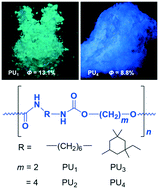当前位置:
X-MOL 学术
›
Mol. Syst. Des. Eng.
›
论文详情
Our official English website, www.x-mol.net, welcomes your
feedback! (Note: you will need to create a separate account there.)
Synthesis, clustering-triggered emission, explosive detection and cell imaging of nonaromatic polyurethanes†
Molecular Systems Design & Engineering ( IF 3.2 ) Pub Date : 2018-01-05 00:00:00 , DOI: 10.1039/c7me00118e Xiaohong Chen 1, 2, 3, 4, 5 , Xundao Liu 1, 2, 3, 4, 5 , Jianlong Lei 1, 2, 3, 4, 5 , Li Xu 1, 2, 3, 4, 5 , Zihao Zhao 1, 2, 3, 4, 5 , Fahmeeda Kausar 1, 2, 3, 4, 5 , Xinyue Xie 1, 2, 3, 4, 5 , Xinyuan Zhu 1, 2, 3, 4, 5 , Yongming Zhang 1, 2, 3, 4, 5 , Wang Zhang Yuan 1, 2, 3, 4, 5
Molecular Systems Design & Engineering ( IF 3.2 ) Pub Date : 2018-01-05 00:00:00 , DOI: 10.1039/c7me00118e Xiaohong Chen 1, 2, 3, 4, 5 , Xundao Liu 1, 2, 3, 4, 5 , Jianlong Lei 1, 2, 3, 4, 5 , Li Xu 1, 2, 3, 4, 5 , Zihao Zhao 1, 2, 3, 4, 5 , Fahmeeda Kausar 1, 2, 3, 4, 5 , Xinyue Xie 1, 2, 3, 4, 5 , Xinyuan Zhu 1, 2, 3, 4, 5 , Yongming Zhang 1, 2, 3, 4, 5 , Wang Zhang Yuan 1, 2, 3, 4, 5
Affiliation

|
Nonconventional luminogens without remarkable conjugation have attracted significant attention due to their scientific and technical importance. Their emission mechanism, however, is still under debate. Recently, we proposed the clustering-triggered emission (CTE) mechanism, namely the clustering of nonconventional chromophores and subsequent electron cloud overlap (delocalization) together with simultaneous conformation rigidification, to rationalize the emission. To further check it, nonaromatic polyurethanes (PUs) bearing carbamate (NHCOO) groups were designed and synthesized. While being virtually nonemissive in dilute PU/DMF solutions, PUs are found to be highly emissive when concentrated or aggregated as powders and films. Furthermore, room-temperature phosphorescence (RTP) is detected from the solid powders and films. Clustering of NHCOO groups and electronic communications among carbonyl (C![[double bond, length as m-dash]](https://www.rsc.org/images/entities/char_e001.gif) O) units, N and O atoms are accountable for the emission. Such stereoelectronic interactions were also corroborated by the liquid IR (LIR) measurement. In addition, the aggregates of PUs are also useful for explosive detection and cell imaging.
O) units, N and O atoms are accountable for the emission. Such stereoelectronic interactions were also corroborated by the liquid IR (LIR) measurement. In addition, the aggregates of PUs are also useful for explosive detection and cell imaging.
中文翻译:

非芳族聚氨酯的合成,簇触发发射,爆炸物检测和细胞成像†
由于非常规发光剂的科学和技术重要性,它们引起了极大的关注。然而,它们的排放机制仍在争论中。最近,我们提出了簇触发发射(CTE)机制,即非常规生色团的簇聚和随后的电子云重叠(离域)以及同时的构象刚性化,以使发射合理化。为了进一步检查,设计并合成了带有氨基甲酸酯(NHCOO)基团的非芳族聚氨酯(PU)。尽管在稀释的PU / DMF溶液中几乎不发光,但发现PU浓缩或聚集成粉末和薄膜时具有很高的发光性。此外,从固体粉末和薄膜中检测到室温磷光(RTP)。![[双键,长度为m-破折号]](https://www.rsc.org/images/entities/char_e001.gif) O)单元,N和O原子是造成发射的原因。液体IR(LIR)测量也证实了这种立体电子相互作用。此外,PU的聚集体也可用于爆炸物检测和细胞成像。
O)单元,N和O原子是造成发射的原因。液体IR(LIR)测量也证实了这种立体电子相互作用。此外,PU的聚集体也可用于爆炸物检测和细胞成像。
更新日期:2018-01-05
![[double bond, length as m-dash]](https://www.rsc.org/images/entities/char_e001.gif) O) units, N and O atoms are accountable for the emission. Such stereoelectronic interactions were also corroborated by the liquid IR (LIR) measurement. In addition, the aggregates of PUs are also useful for explosive detection and cell imaging.
O) units, N and O atoms are accountable for the emission. Such stereoelectronic interactions were also corroborated by the liquid IR (LIR) measurement. In addition, the aggregates of PUs are also useful for explosive detection and cell imaging.
中文翻译:

非芳族聚氨酯的合成,簇触发发射,爆炸物检测和细胞成像†
由于非常规发光剂的科学和技术重要性,它们引起了极大的关注。然而,它们的排放机制仍在争论中。最近,我们提出了簇触发发射(CTE)机制,即非常规生色团的簇聚和随后的电子云重叠(离域)以及同时的构象刚性化,以使发射合理化。为了进一步检查,设计并合成了带有氨基甲酸酯(NHCOO)基团的非芳族聚氨酯(PU)。尽管在稀释的PU / DMF溶液中几乎不发光,但发现PU浓缩或聚集成粉末和薄膜时具有很高的发光性。此外,从固体粉末和薄膜中检测到室温磷光(RTP)。
![[双键,长度为m-破折号]](https://www.rsc.org/images/entities/char_e001.gif) O)单元,N和O原子是造成发射的原因。液体IR(LIR)测量也证实了这种立体电子相互作用。此外,PU的聚集体也可用于爆炸物检测和细胞成像。
O)单元,N和O原子是造成发射的原因。液体IR(LIR)测量也证实了这种立体电子相互作用。此外,PU的聚集体也可用于爆炸物检测和细胞成像。











































 京公网安备 11010802027423号
京公网安备 11010802027423号